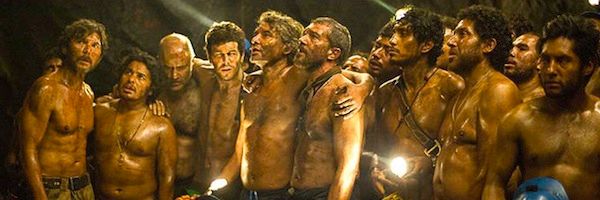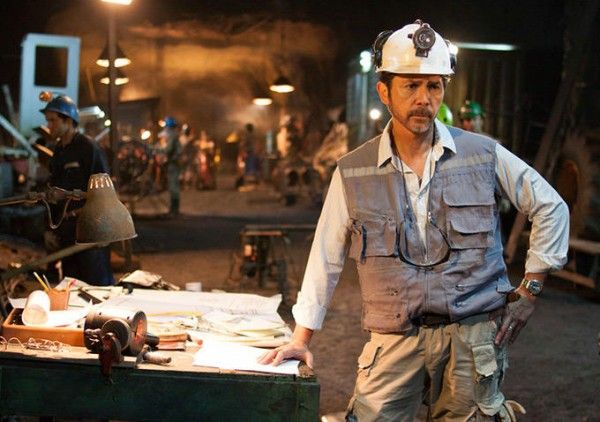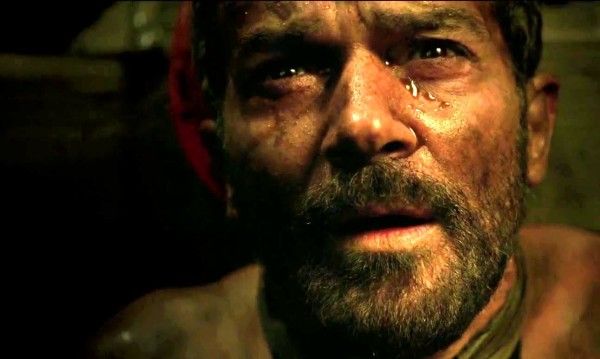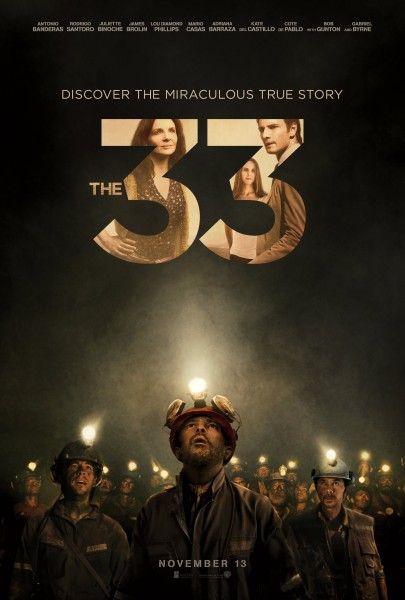In 2010, most of the world watched hours and hours of news footage of the attempts to safely remove the 33 Chilean miners who were trapped underground for more than two months. Five years later—after witnessing the impossible survival live on television, perhaps even after reading up on the survivors and following the news that they still haven't been paid by the company that put them in such danger—you might wonder, why would I watch a movie when I've already followed the story so closely? It was inevitable that a movie of this harrowing and triumphant story would be made. It's also inevitable that it wouldn't plunge too deep into the men beyond easy archetype personalities. And thus, we have The 33, which fulfills the surface level prophecy, but also shows a studio director with potential to do more, if she wasn't saddled with such a simple script.
Patricia Riggen (Under the Same Moon) stages the mine collapse with proper immediacy, suspense, and terror. She also bravely inserts a fantasy sequence when the men hold what they think is their last supper—after rationing far beyond the allotted three day limit. The 33 that would've been more interesting could've mined cabin fever as she does in that one sequence (although it only partially works, it is very inspired).
The script—from three credited writers (Mikko Alanne, Michael Thomas, and Dallas Buyers Club's Craig Borten) and one additional story credit (Jose Rivera)—is far more crowded than it should be. Nine of the 33 are given sizable speaking roles and nine of their significant others, worrying on the surface, are also given some time. There's the resourceful family man (Antonio Banderas), the stoic overseer who warns the company man about the instability of the mine (Lou Diamond Philllips), the young father to be (Mario Casas), the ne'er do well (Juan Pablo Raba), the two-timing comic relief (Oscar Nunez), the immigrant (Tenoch Huerta), the old man (Gustavo Angarita), the religious man (Marco Trevino), and the Elvis impersonator (Jacob Vargas). None of these men extend their characters beyond their initial introduction of those archetypes, but Banderas and Phillips sure do get to shout a lot.
On the surface, the always great Juliette Binoche leads the women who want answers from the company or the government. However, it is her character who is the most poorly written of anyone. From her first overdone encounter with a government official (Rodrigo Santoro) it is obvious that this doting sister (to the ne'er do well) is there to push forward all the surface plot. She will be the one woman who the government official approaches to give all updates and reassurances (she's the international female star after all, and dare we bring it up, the white woman in an international cat) and through that partnership she will tell a story in a time of direness that will unconvincingly lead to an aha moment to further assist the men trapped hundreds of meters underground. Her relationship with her brother is never fleshed out. How did they let each other down? And her impulse action after he's safe, only adds forced drama to what is supposed to be euphoria.
The script also largely disappears for the third act, which is mostly told via newscaster footage—both recreated and real—that most of the world saw. But it isn't just the script that lets Riggen down. With all due respect to composer James Horner, who had a great career—full of many fantastic, classic scores—who passed away in a plane crash this year, and to whom the film is dedicated to, the music is almost always working against what we're seeing in The 33. For example, during the hellish collapse of the mountain—in which the men are struggling to outrun the tons of rubble that unleashes overpowering dust clouds and drop the men into darkness—Horner's score leaps and jumps like a Hobbit adventure fantasy. The sounds of the earthy carnage would've been more than enough, instead Horner's score tries to thrill when we should be feeling hopelessness and horror.
The 33 means well, it respects the men for surviving, and those who helped to drill them out, but for the film to be great it'd have to respect the darkness more than the light. That is where Riggen shows flashes of cinematic mountain-building capability, but many of her collaborators follow those moments with simplicity: thrills, spills, and unconvincing lightbulb moments.
Rating: C
The 33 is in thaters, October 13.
Click here for all of our AFI 2015 coverage. Click on the links below for our other reviews.




